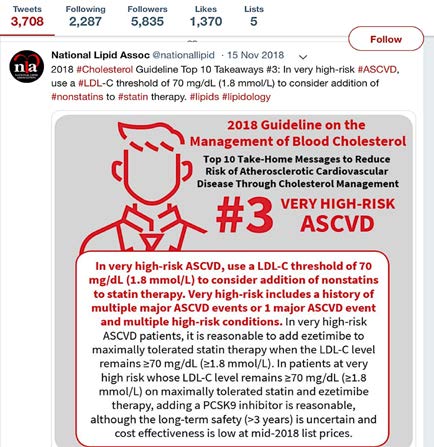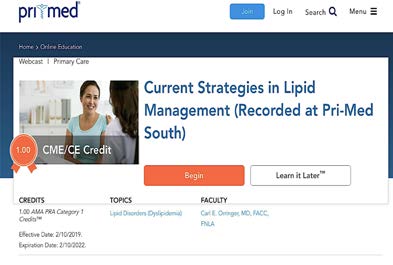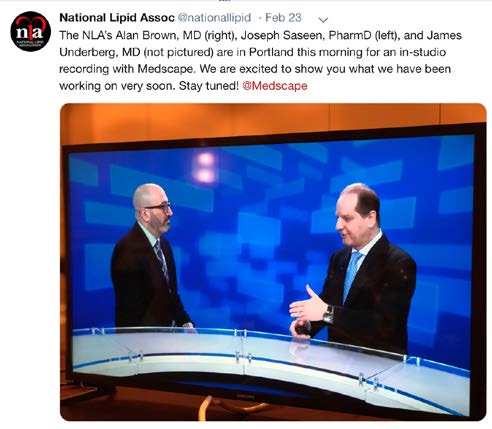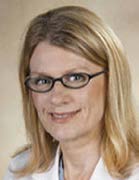Discuss this article at www.lipid.org/lipidspin
It has been more than 30 years since the first National Cholesterol Education Program (NCEP) lipid treatment guideline was published in January 1988 in the Archives of Internal Medicine.(1) At the time, few clinical practice guidelines existed. Moreover, the cholesterol hypothesis had generated considerable controversy, and the evidence to support a patient approach to cholesterol-lowering, especially for primary prevention, still was slim. .jpg) Yet, as ground breaking – and, ultimately, practice-changing – as the first NCEP guideline was, it was disseminated in the only way possible in 1988 – slowly. After the original print publication, some lay press articles followed, expert commentary began to appear in the literature and didactics and debates took place weeks and months later at scientific meetings. There were no e-blasts, Twitter or Instagram posts and no YouTube videos, websites, webinars or podcasts.
Yet, as ground breaking – and, ultimately, practice-changing – as the first NCEP guideline was, it was disseminated in the only way possible in 1988 – slowly. After the original print publication, some lay press articles followed, expert commentary began to appear in the literature and didactics and debates took place weeks and months later at scientific meetings. There were no e-blasts, Twitter or Instagram posts and no YouTube videos, websites, webinars or podcasts.
Now, 30 years later, sponsorship and dissemination of the principal US lipid treatment guidelines are vastly different. The guideline has become a multisociety document and, thanks to digital technology, its dissemination has become lightning fast. For the NLA, which had four members on the writing committee, it was important to showcase our involvement in the 2018 version, quickly disseminate it to our members and provide early and broad expert commentary. To accomplish these goals, NLA Executive Director Brian Hart, JD; President Alan S. Brown, MD, FACC, FNLA and the executive committee strategically planned, coordinated and rolled out a staged guideline dissemination and education process. The plan called for an “all hands on deck” approach that involved the Communications, Education, Science and Policy and Practice Management councils, all supported by the dedicated volunteers and staff who work on behalf of the organization.
Executive-level planning that took place well before the guideline was released helped define the communications and education strategy, and the organization’s official talking points. A traditional .jpg) news release, timed with publication of the guideline, highlighted the role of the NLA in the writing process, its unanimous endorsement by the Board of Directors of the document and those concepts most aligned with NLA positions. After that, social media and other online activities were rolled out fast. During the Nov. 10, 2018 guideline presentation at the American Heart Association (AHA) Annual Scientific Session in Chicago, the NLA posted to its Twitter feed live images of writing committee member and past-NLA President Dr. Carl Orringer and writing committee co-chair and NLA member Dr. Neil Stone making their presentations before the “Big Tent” crowd.(2)(Figure 1) Immediately after the AHA presentation, a YouTube video(2) featuring expert commentary by Drs. Alan Brown, Carl Orringer and Peter Jones was recorded, posted and disseminated via the NLA website, and plans were made for its wider distribution via Medscape channels. (Figure 2) A few days later, a fabulouslooking, patient-friendly digital infographic of the 2018 guideline developed by NLA leadership and its Social Media Committee was sent to the NLA Twitter feed.(Figure 3) To further engage our energized members via social media, a formal NLA “Twitter Chat on the Cholesterol Guideline” was hosted Feb. 6, 2019, by Drs. Dave Dixon, Casey Elkins and Lynne Braun, another member of the guideline writing committee.(Figure 4) And we were just getting started.
news release, timed with publication of the guideline, highlighted the role of the NLA in the writing process, its unanimous endorsement by the Board of Directors of the document and those concepts most aligned with NLA positions. After that, social media and other online activities were rolled out fast. During the Nov. 10, 2018 guideline presentation at the American Heart Association (AHA) Annual Scientific Session in Chicago, the NLA posted to its Twitter feed live images of writing committee member and past-NLA President Dr. Carl Orringer and writing committee co-chair and NLA member Dr. Neil Stone making their presentations before the “Big Tent” crowd.(2)(Figure 1) Immediately after the AHA presentation, a YouTube video(2) featuring expert commentary by Drs. Alan Brown, Carl Orringer and Peter Jones was recorded, posted and disseminated via the NLA website, and plans were made for its wider distribution via Medscape channels. (Figure 2) A few days later, a fabulouslooking, patient-friendly digital infographic of the 2018 guideline developed by NLA leadership and its Social Media Committee was sent to the NLA Twitter feed.(Figure 3) To further engage our energized members via social media, a formal NLA “Twitter Chat on the Cholesterol Guideline” was hosted Feb. 6, 2019, by Drs. Dave Dixon, Casey Elkins and Lynne Braun, another member of the guideline writing committee.(Figure 4) And we were just getting started.
By early February, a two-page downloadable NLA Clinician Tear Sheet that summarized the 2018 guideline had been written by the Practice Management Committee co-chairs, reviewed by NLA members of the guideline-writing committee and posted on the website (and Twitter feed) as a quick guide and decision support tool.(4) Planning also had been completed by the Scientific Meetings Committee, co-chaired by Drs. Alan Brown and Anne Goldberg, for guideline education at the NLA’s upcoming live sessions. The Spring Clinical Lipid Update on Feb. 22-24, 2019 in Portland, Oregon, featured an opening session “fireside chat” by Drs. Neil Stone and Alan Brown on the primary prevention aspects of the 2013 and 2018 guidelines, and a second session by guideline committee members Drs. Carl Orringer, Lynne Braun and Kim Birtcher on “Finding Guidance in the Guidelines.” A Medscape session also was recorded in Portland and is being prepared for online dissemination. (Figure 5) Plans were made for guideline education May 16-19, 2019, at the NLA Annual Scientific Sessions In Miami, Florida, which featured a session on practice guidelines, including the  2018 U.S. cholesterol guideline and the International Atherosclerosis Society’s dyslipidemia management guideline. Broader educational opportunities also were developed. Thanks to the work of the Project Review Committee, the NLA has partnered with Pri-Med to present recorded 2018 guideline live sessions by Drs. Carl Orringer, Dan Soffer and Margo Minissian at Pri-Med primary care conferences during the first half of
2018 U.S. cholesterol guideline and the International Atherosclerosis Society’s dyslipidemia management guideline. Broader educational opportunities also were developed. Thanks to the work of the Project Review Committee, the NLA has partnered with Pri-Med to present recorded 2018 guideline live sessions by Drs. Carl Orringer, Dan Soffer and Margo Minissian at Pri-Med primary care conferences during the first half of  2019. The first of these are available as online CME/CE activities for up to 12 months (Figure 6). For its members, the NLA already has revised its two main courses – Foundations of Lipidology and Masters in Lipidology – to include the 2018 guideline’s new content and concepts. The NLASAP, set to expire in 2019, will be revised to include 2018 cholesterol guideline content and questions. Also, at the time of this writing, Drs. Linda Hemphill and Nataliya Pyslar are developing an official NLA slide deck on the 2018 lipid treatment guideline, for educational use by members. Finally, the NELA board and LipidSpin editors Dr. Dan Soffer and Dr. Kaye Eileen Willard have dedicated this entire edition to the 2018 lipid guidelines.
2019. The first of these are available as online CME/CE activities for up to 12 months (Figure 6). For its members, the NLA already has revised its two main courses – Foundations of Lipidology and Masters in Lipidology – to include the 2018 guideline’s new content and concepts. The NLASAP, set to expire in 2019, will be revised to include 2018 cholesterol guideline content and questions. Also, at the time of this writing, Drs. Linda Hemphill and Nataliya Pyslar are developing an official NLA slide deck on the 2018 lipid treatment guideline, for educational use by members. Finally, the NELA board and LipidSpin editors Dr. Dan Soffer and Dr. Kaye Eileen Willard have dedicated this entire edition to the 2018 lipid guidelines.
The NLA’s guideline dissemination and education efforts likely will continue well into 2019. Look for upcoming editorial content by editor Dr. John Guyton in the Journal of Clinical Lipidology and for a possible CLM-SAP on the 2018 Guideline to be spearheaded by the Education Committee and Dr. Joseph Saseen, another guideline writing committee member. Also being considered are possible revisions to the NLA Recommendations on Patient-Centered Dyslipidemia.
Yes, it’s a very different world from 1988. Some 30 years after the first evidencebased lipid treatment guideline was boldly released by the NCEP, a fifth update endorsed by 12 medical societies was instantaneously disseminated – and by an organization of professionals dedicated solely to lipid treatment and prevention. Let’s thank our visionary lipidology and prevention leaders, past and present. 

Disclosure statement: Dr. Aspry received honoraria from Medscape/WebMD, Amgen, Akcea, and Experion.





.jpg)
.png)











